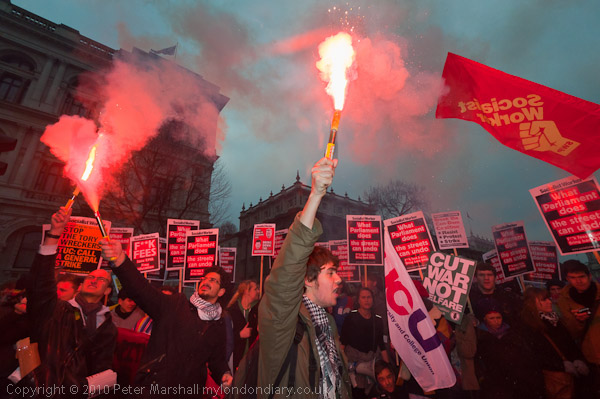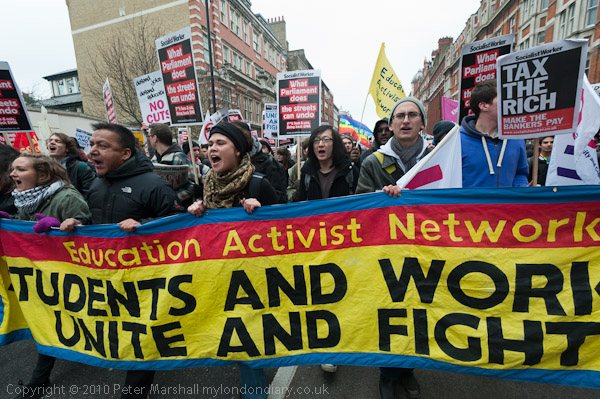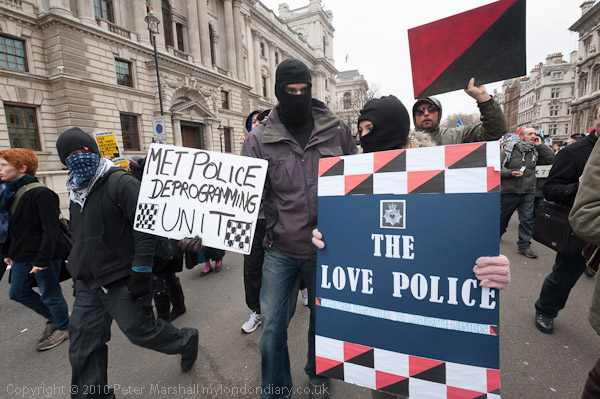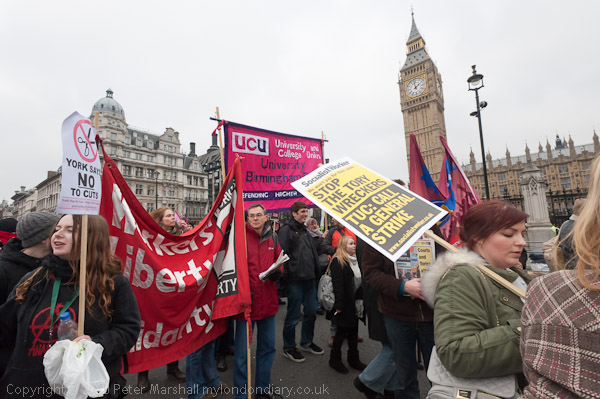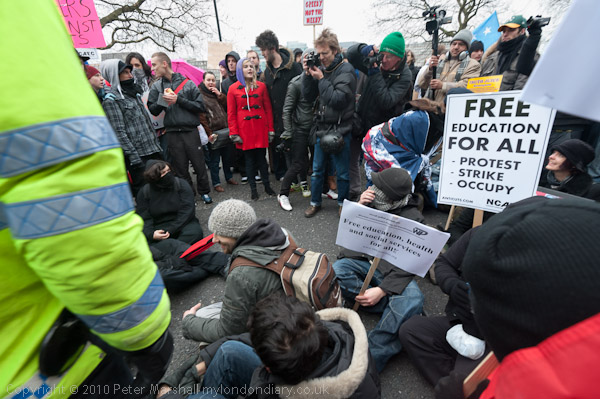Education Cuts & Egyptian Revolution: People were protesting on the streets of London on Saturday 29th January 2011 in solidarity with demonstrations in Egypt at the Egyptian Embassy. Elsewhere students, teachers, parents and others took part in a large peaceful march against increases in student fees and cuts in education and public services.
Solidarity with the Egyptian Revolution – Egyptian Embassy, South St. Mayfair
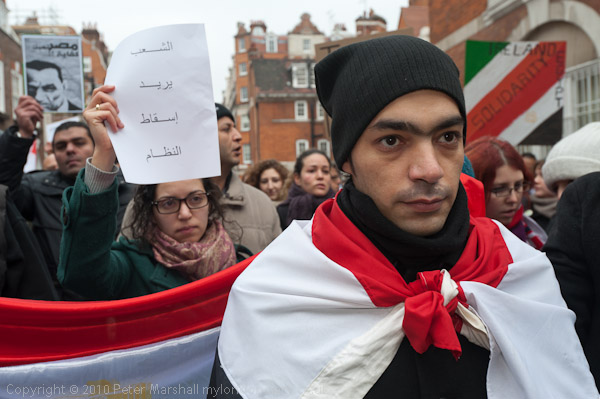
Around 200 people, mainly Egyptians living in the UK had come to the street outside the embassy for peaceful but noisy protest “to show our solidarity & support of our fellow Egyptians in our beloved country, who decided on making Tuesday 25/01/2011 a day of protests & demonstrations in Egypt against the unfair, tyrant, oppressive & corrupt Egyptian regime that has been ruling our country for decades.“
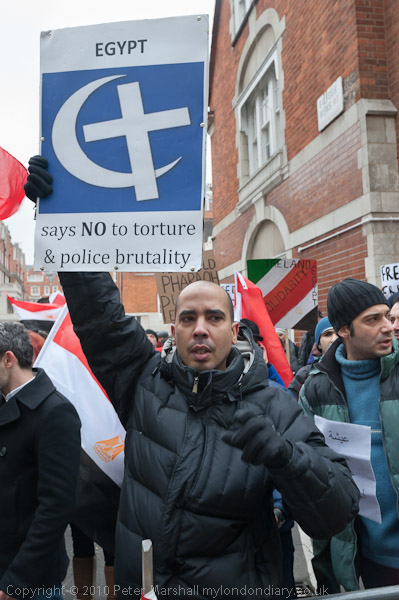
The protest had brought together Egyptians from differing political & ideological backgrounds, inviting “inviting all supporters of human rights & civic democracy to come & support us in delivering our message to the Egyptian regime.”
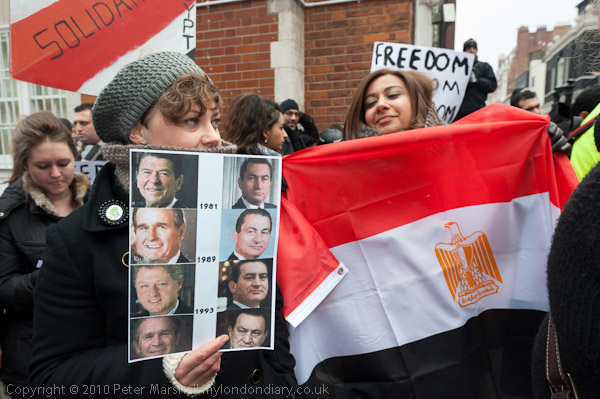
Their stated goal was to achieve “a democratic, free & civil nation capable of ensuring a dignified, honourable & non-discriminatory life for all Egyptians.“
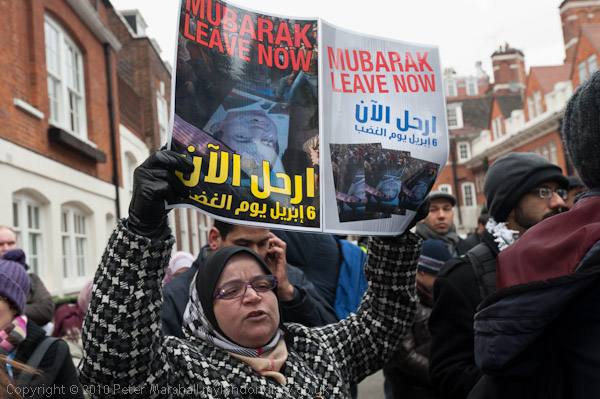
Although the Arab uprising in Egypt in 2011 achieved some of its aims, including the end of the 30 year dictatorship of President Hosni Mubarak, it was followed by a struggle with the Muslim Brotherhood gaining power and Mohamed Morsi being elected as president in June 2012 only to be overthrown a few months later and the countrycpoming under the military regime led by Abdel Fattah el-Sissi since 2014.
In an interview with German news organisation DW ten years after the upraising an Egyptian activist commented “The counterrevolution has pushed the country into a state that is even more oppressive than before the 2011 revolution. The uprising has taken a terrible turn and has led to a tremendous regression.”
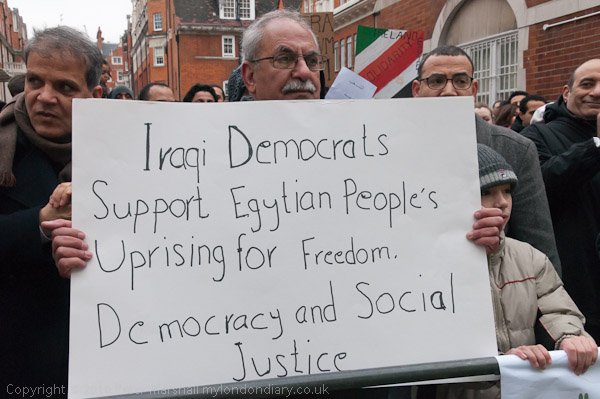
The protesters aimed to bring together people from across a wide range of political viewpoints, they refused to allow Hizb Ut-Tahrir protesters to join them, as they are opposed to human rights and democracy.
More pictures Solidarity with the Egyptian Revolution
Hizb ut-Tahrir Turned Away – South Audley St
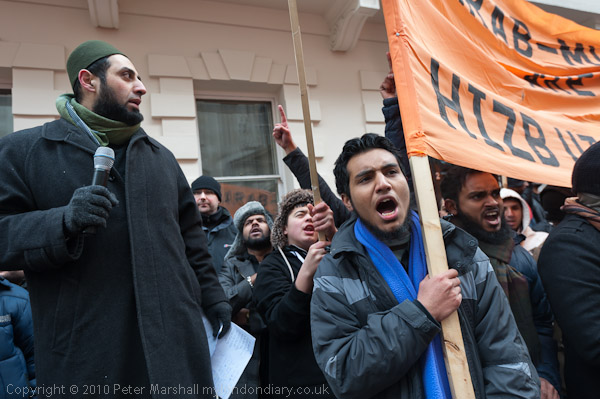
Hizb Ut-Tahrir Britain, an Islamist group calling for the establishment of a Muslim caliphate, marched to the Egyptian Embassy to take part in the protest there but were turned away.
When they arrived they were met by Egyptians taking part in the protest and told very firmly that the embassy protest – like the Egyptian revolution – was to be entirely non-sectarian and that they were not welcome there.
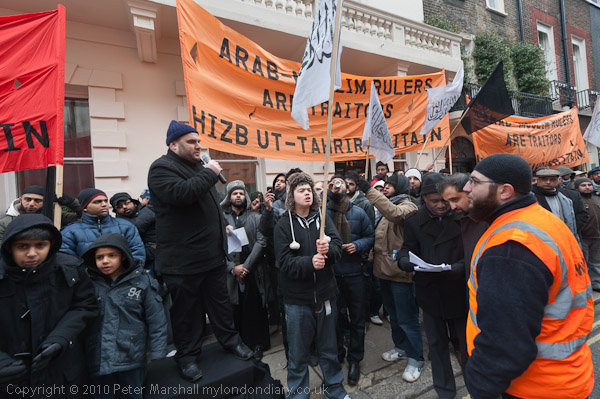
Instead they had to hold their own separate demonstration around a hundred yards away around the corner along South Audley St, where they were spread out along the pavement between South Street and Hill Street.
As always at their events, everyone was dressed in black and the men and women were segregated. The men filled most of the pavement along South Audley St, with just a few women at one end, with most of them around the corner eastwards on South Street, away from the loundspeakers and the embassy.
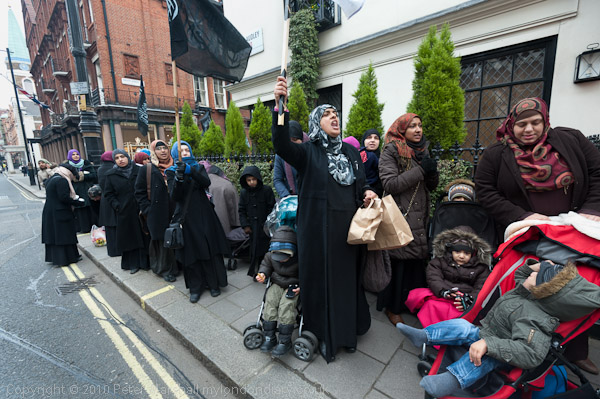
As I commented it seemed a clear demonstration of the lack of equality they would like to impose. None of the speeches while I was there was in English, but I was able to gather that they were calling for Egypt to come under the rule of an Islamic Khalifah (caliphate), the “real change” which they see as the answer to everything.
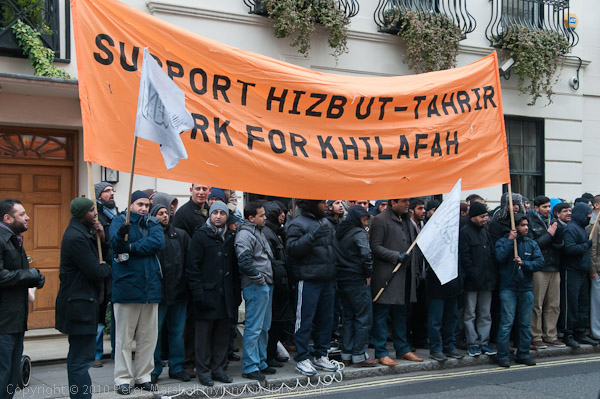
It was a call diametrically opposed to the aims of the Egyptian revolution, which aimed to get rid of the oppressive regime and make Egypt a free and democratic nation, a secular state where there is no discrimination based on gender, religion or political views. The last thing they wanted was to replace one repressive regime by another, though depressingly that was what the future held for their country.
No Fees, No Cuts! Student March
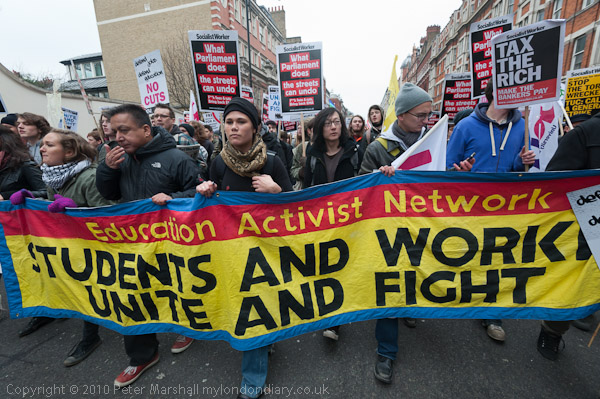
The National Campaign Against Fees and Cuts had organised two large national protests in London and Manchester to defend education and the public sector. They took place a little over two months after another large student march had ended with a small group walking into the Tory HQ at Millbank and occupying it.
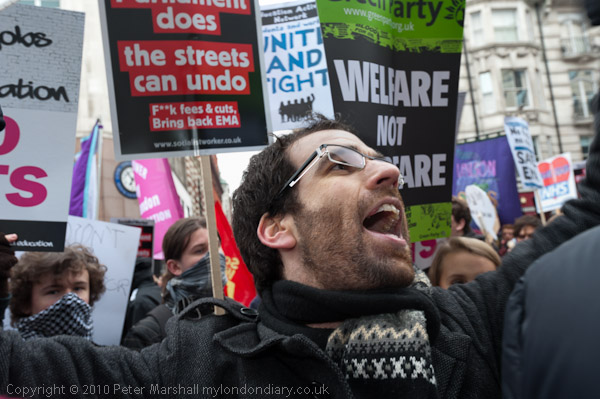
On that occasion the police had tried to carry out a brutal eviction and were met with an angry response, with the protesters smashing large plate glass windows to allow others to enter, though few did. A number of protesters and press were injured by police (and a few police injured too), though most of those at the scene simply watched from outside in the courtyard and were appalled when a stupid idiot threw an empty fire extinguisher from the roof and began to chant against him. Fortunately no-one was killed. But the event made the headlines of those media organisations which generally turn their blind eye to protests, though the reports didn’t much engage with the reasons for the protest or report fairly on all that had happened.
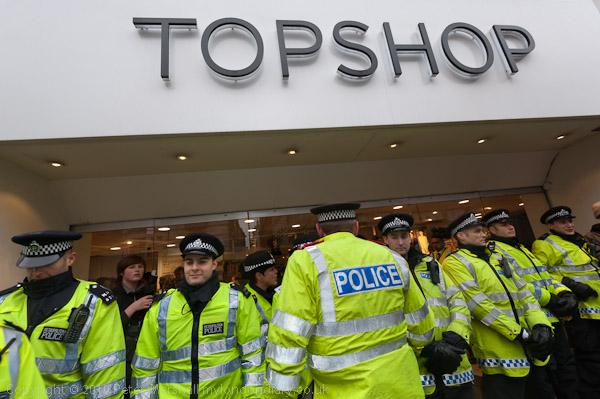
Police seemed to have learnt some lessons from their mistakes on that occasion and made much greater efforts to communicate sensibly with the protesters and not to kettle them or push them around. As I wrote “Despite the number of protesters in anarchist dress with facemasks, most students are not out to cause trouble.”
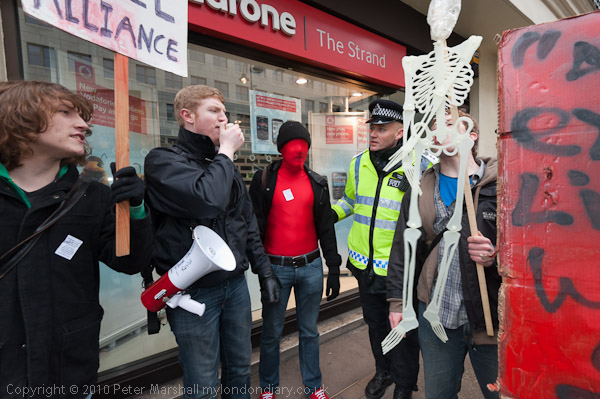
The march had begun with a short rally in Malet Street and I met it as the front was making its way out of Russell Square walking with it and taking pictures of the marchers and of short protests at Topshop and Vodaphone shops in Strand against their tax avoidance. Police lined the front of the shops and soon persuaded the protesters to move on.
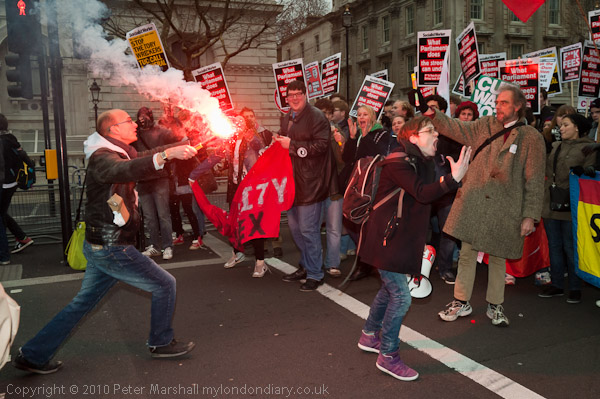
Things livened up a little outside Downing Street were the march paused for some angry shouting and several people let of smoke flares before moving on. Many stopped for a while in Parliament Square, with some dancing to a samba band, but after a while everyone moved off to where the march was to end outside Tate Britain on Millbank.
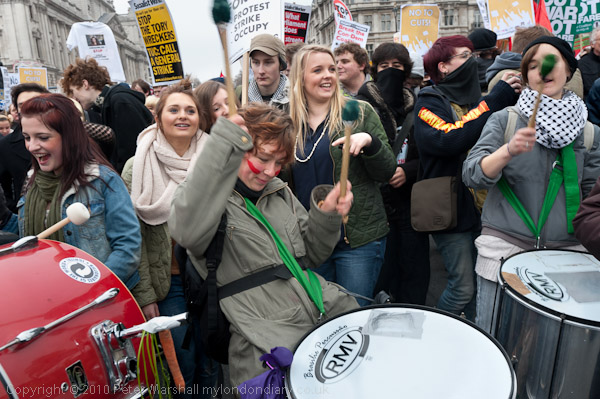
Unlike in the previous November there was a large group of police lined across the entire frontage of the Millbank tower complex – bolting the stable door as I think it unlikely that there would have been any trouble.
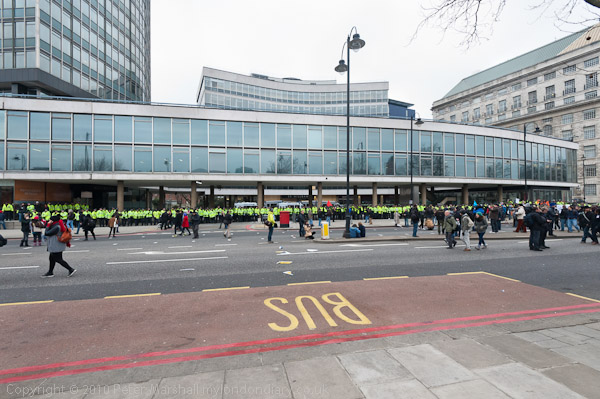
The only sign of any conflict between police and protesters I saw did come outside here, when there was a brief sit-down after police tried to drive two vans full of reinforcements through the crowd. Sensibly the police simply brought in a line of officers to allow the vans to drive along the pavement rather than try to force people to move.
By the time I arrived outside Tate Britain with the tail of the march they rally there had ended and I decided it was time to leave, though some of those on the protest were planning to continue elsewhere – including going to the Egyptian Embassy where I had been earlier. Later at home I read reports on-line that half a dozen people had been arrested in minor incidents.
Flickr – Facebook – My London Diary – Hull Photos – Lea Valley – Paris
London’s Industrial Heritage – London Photos
All photographs on this page are copyright © Peter Marshall.
Contact me to buy prints or licence to reproduce.
